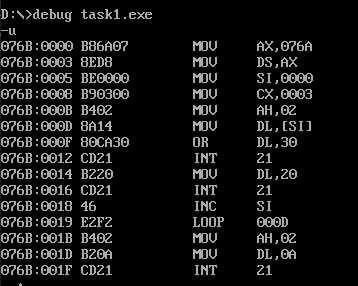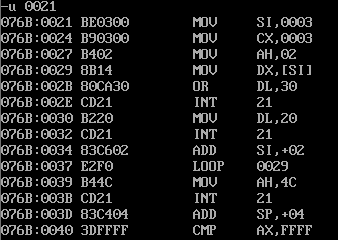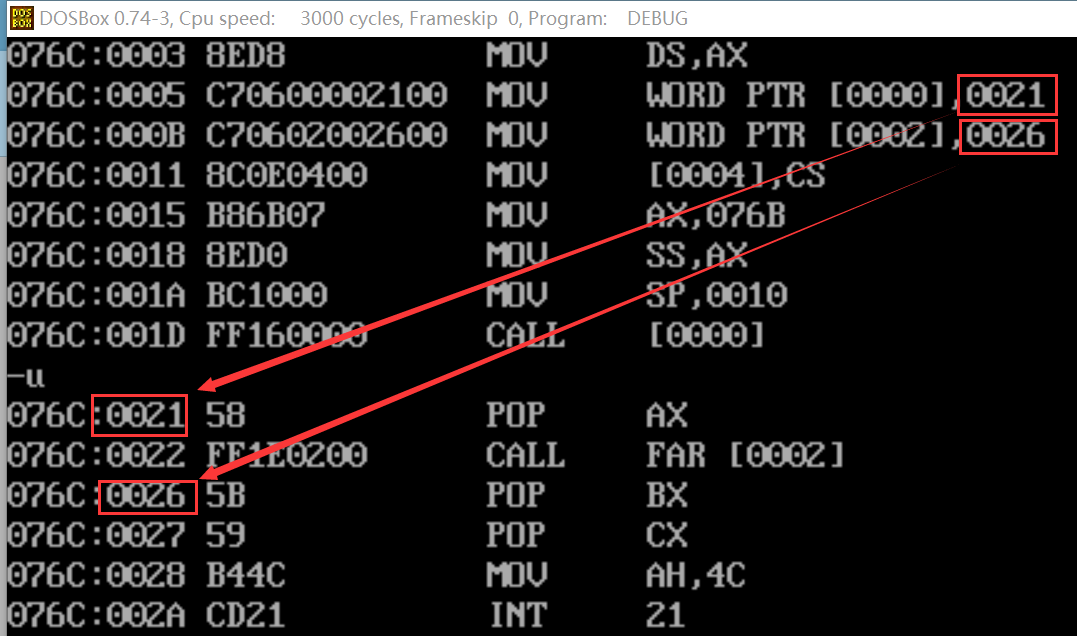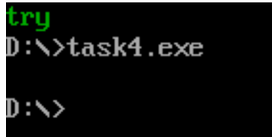Experimental task 1
assume cs:code, ds:data data segment x db 1, 9, 3 len1 equ $ - x ; y dw 1, 9, 3 len2 equ $ - y ; data ends code segment start: mov ax, data mov ds, ax mov si, offset x ; mov cx, len1 ; mov ah, 2 s1:mov dl, [si] or dl, 30h int 21h mov dl, ' ' int 21h ; inc si loop s1 mov ah, 2 mov dl, 0ah int 21h ; mov si, offset y ; mov cx, len2/2 ; mov ah, 2 s2:mov dx, [si] or dl, 30h int 21h mov dl, ' ' int 21h ; add si, 2 loop s2 mov ah, 4ch int 21h code ends end start

① line27, when the assembly instruction loop s1 jumps, it jumps according to the displacement. Check the machine code through debug disassembly and analyze the jump displacement? (the displacement value is answered in decimal) from the perspective of the CPU, explain how to calculate the offset address of the instruction after the jump label s1.

The displacement is: 14 (the end address of Loop instruction is 001B, the start address of s1 instruction is 000D, 001B-000D=14)
Analysis: the or dl, 30h command occupies three bytes, the inc instruction occupies one byte, and other instructions occupy two bytes respectively. The total is 14 bytes.
② line44. When the assembly instruction loop s2 jumps, it jumps according to the displacement. Check the machine code through debug disassembly and analyze the jump displacement? (the displacement value is answered in decimal) from the perspective of the CPU, explain how to calculate the offset address of the instruction after the jump label s2.

Displacement: 16 (Loop instruction end address: 0039, s1 instruction start address: 0029001B-000D=16)
Analysis: the or DL and 30h commands occupy three bytes, and other instructions occupy two bytes respectively. The total is 16 bytes.
Experimental task 2
assume cs:code, ds:data data segment dw 200h, 0h, 230h, 0h data ends stack segment db 16 dup(0) stack ends code segment start: mov ax, data mov ds, ax mov word ptr ds:[0], offset s1 mov word ptr ds:[2], offset s2 mov ds:[4], cs mov ax, stack mov ss, ax mov sp, 16 call word ptr ds:[0] s1: pop ax call dword ptr ds:[2] s2: pop bx pop cx mov ah, 4ch int 21h code ends end start
① According to the jump principle of call instruction, it is analyzed theoretically that before the program executes to exit (line31), register (ax) =? Register (bx) =? Register (cx) =?
A: theoretically, the data in ax should be the IP address of the instruction s1:pop ax. Because call word ptr ds:[0] pushes the IP of the s1:pop ax instruction onto the stack.
bx should be the IP of s2:pop bx, and cx should be the CS of s2:pop bx.
Because call dword ptr ds:[2] Instruction will S2: CS and IP of pop BX are successively pushed into the stack.
② Assemble and link the source program to get the executable program task2.exe. Use debug to observe and verify whether the debugging results are consistent with the theoretical analysis results.

Experimental task 3
assume cs:code, ds:data data segment x db 99, 72, 85, 63, 89, 97, 55 len equ $ - x data ends code segment start: mov ax, data mov ds, ax mov ax, 0b800h mov es, ax mov bx,0 mov si,0 mov cx,len s:mov al, [si] mov ah, 0 call printNumber add bx, 2 call printSpace inc bx inc si loop s mov ax, 4c00h int 21h printNumber: mov dl, 10 div dl or al, 30h ;merchant or ah, 30h ;remainder mov dh, ah mov ah, 2 mov dl, al int 21h mov dl, dh int 21h ret printSpace: mov ah, 2 mov dl, ' ' int 21h ret code ends end start

Experimental task 4
assume cs:code, ds:data data segment str db 'try' len equ $ - str data ends code segment start: mov ax, data mov ds, ax mov dh, 0 mov bl, 2 mov si, 0 mov ax, 0b800h mov es, ax call printStr mov dh, 24 mov bl, 4 mov si, 0 call printStr mov ax,4c00h int 21h printStr: mov al, 160 mul dh mov dx, ax mov al, bl mov bx, dx mov cx, len s: mov dl, [si] mov es:[bx], dl inc bx mov es:[bx], al inc bx inc si loop s ret code ends end start

Experimental task 5
assume cs:code, ds:data data segment stu_no db '20192375030' len = $ - stu_no data ends code segment start: mov ax, data mov ds, ax mov ax, 0b800h mov es, ax mov si, 1 mov dl, 17h mov cx, 2000 bc:mov es:[si], dl add si, 2 loop bc mov dh, 24 mov al, 160 mul dh mov bx, ax call minus mov si, 0 mov cx, len s1:mov dl, [si] mov es:[bx], dl add bx, 2 inc si loop s1 call minus mov ax, 4c00h int 21h minus: mov dl, '-' mov cx, 34 s:mov es:[bx], dl add bx, 2 loop s ret code ends end start
